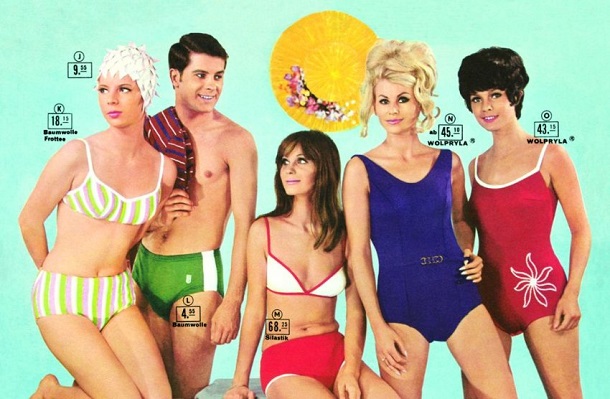She rises from the sea – and 007 could think of nothing more. Bond girl Ursula Andress did in the sixties bikini for fashion hit. Hard to believe: Four decades before we even splashed in corsets and dresses.
When Sean Connery stepped out from behind the trees to see who so adorable hinträllerte there before him, he could not believe his eyes. From the waters slipped a blonde beauty in an off-white cotton bikini, at the belt dangled a fearsome clam knife. The otherwise hard-nosed James Bond just speechless. In the state of absolute rapture the secret agent of Her Majesty finally began intoning of the Mermaid hits “Underneath the mango tree” nachzusingen – and thus to lay a unlässigsten his performances.
After this little scene from the 1962 “James Bond Dr. No chasing” nothing was like before. Not only that, the Swedish actress Ursula Andress (nicknamed “Undressed”), thanks to its spectacular appearance as Honey Ryder seeker mussel international breakthrough. The episode also encouraged the triumph of a garment that had as little a second cleaved tempers and caused an uproar.

Without meaning to, the makers of the macho agent strip had ended a true war for female Swimwear, raged since the beginning of the 20th century and the world divided into two halves: on the one hand, the guardians of morality and public order – the increasingly self-confident, sporty and slim fit women who refused to be dictated to in what gear they jumped on the other side into the cool water.
Bikini History:Wall Substances monsters, baggy flannel tunic

Annette Kellermann, for example. “I want to swim, and I can not with a clothesline full of fabric on my body,” raged the Australian swimmer and acquitted himself unceremoniously textile materials before they jumped into the water. Prompt she was arrested in 1907 on the beach of Boston public nuisance because of excitement – the ladies present had called the police because they disliked the black, tight-fitting plus plenty of bare skin revealing wool jersey of the athlete.
Shortly afterwards, again caused a swimmer with her outfit for riot: 1910 joined the Englishwoman Gladys Osborne their competitions with a silk bathing suit, which, once wet, so much femininity showcased realized that the male spectators were allowed only if they have a morally acceptable safety distance to the pool einhielten. After all, the athlete did not land in court – for those times a success.

For at least publicly, women could be a few years before, only to let water when her charms completely veiled and swimsuit plus bath cap, bathing stockings and bathing shoes wore – even bare feet were long considered obscene.
Bikini History:”We do not want Gorillas at the beach!”

But that’s not enough: The sight of bare female leg has long been frowned upon so that the women sometimes even weights on their bathing skirts attached, so that the buoyancy in the water had come to light no naked flesh. A fatal incident of moral guardians – often chuckling mastered the so complained ladies in their moreover soaked with water, pound bathing clothes just from when they ventured too far into the sea by splashing. And yet in 1892 had to die a Berlin swimming student, because their teacher could not hatch fast enough from their complex swimming gear to rush to the drowning man to help.
Around the turn of the century the era of Walle-water costume ended. The bathing suits were, but were increasingly shorter – until after the First World War not only professional swimmers, but also amateur Baigneusen in skintight, far above the knee ending jersey swimsuit jumping on the beach. Then, when even sunbathing became fashionable and swimming fans a shell after another dropped, it gave the German authorities.
In October 1932, the Prussian Reich Minister of the Interior and Commissioner Franz Bracht imposed the so-called gusset decree that not only prohibited nude bathing, but also meticulously regulated, what body parts had to conceal men and women. Henceforth patrolled swimming policemen at German beaches and lakes to watch the tape measure on compliance with the rigid dress code. And even in America raged the moral guardians: “We do not want Gorillas on the beach!” proclaimed the city fathers of Atlantic City in 1936 and demanded the men to cover their hairy stimuli future from the neck to the thighs.
Bikini History:”Even smaller than the smallest bathing suit in the world”

In the long term, however, prevailed the fraction of permissive – albeit against massive opposition. On 5 July 1946, a muggy day, a trained mechanical engineer and late appointed Swimwear Designer Louis Réard presented in Paris Art Nouveau swimming pool “Molitor” his latest creation: a four tiny fabric triangles two-parter, he baptize Bikini and so one, albeit macabre, proved sense of PR.
Only four days earlier US-Prädident Harry S. Truman explode an atomic bomb over the Bikini Atoll – no wonder that also named after the Pacific island realm Palm bathing costume struck like a bomb. Since the decent mannequins had refused to pose with the liberal outfit, the fashion designers, the striptease dancer Micheline Bernardini sent unceremoniously to the catwalk. The media went in to celebrate the two-parter, the Réard spent as his invention – although he had stolen the idea for it from a Paris couturier.
“Even smaller than the smallest bathing suit in the world”: this slogan Réard campaigned for the bikini and let his creation of the striptease dancer only pass through a wedding ring to make the rag then disappear in a matchbox. The advertising coup had succeeded, the fine company, including nuclear opponents moralist and priest however, showed not amused. While Catholic countries summarily banned the skimpy two-piece, founded guardians of public morality in Rio de Janeiro in 1947 even an anti-bikini club.
Bikini History:By water sermon against permissive splashing

In 1957 wrote the “magazine for the modern girl”: “It is here probably not necessary to waste words over the so-called Bikini For it is inconceivable that a girl with tact and decency would ever wear something so..” And two years later the priest August Wehage from the pulpit of his church in Oldenburg town Friesoythe near Cloppenburg railed so harshly against the figure-hugging swimsuits his time, that the City Council was forced to act: Five days after the so-called water sermon came together community leaders to the sex-segregated splashing in public institutions to re-introduce.
In the long run, however, even the most rigid bathing regulations fell the urge of female self-determination to the victim. While especially Hollywood stars such as Brigitte Bardot and Diana Dors posing in the fifties in bikinis, changed in the summer of 1959, finally, the trend-setting fashion magazines their opinion and praised the bikini as “garment of the season”. Shortly after, Ursula Andress emerged from the waters – and transformed the once-scorned two-parter in the must-have accessory of all self-confident women who want to exude eroticism and emancipation alike.
Two years after the spectacular Bikini Bond appearance struck again the moral high ground to: Munich Justice thundered a 17-year-old to three weekends cleaning in a nursing home because she was strolling on a hot July day in bikini on the Viktualienmarkt. Thereafter, however, ebbed out of the passionate struggle for the right female swimwear more and more – only the bare breasts on the beaches of the seventies rang the guardians of public morals again a brief outcry from.
[adrotate group=”13″]



